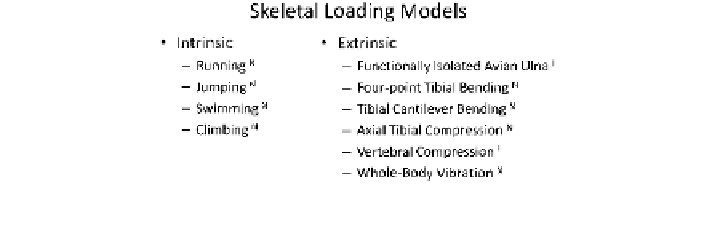Biomedical Engineering Reference
In-Depth Information
Fig. 1 Models used in animal studies of skeletal responses to mechanical loading. (N non-
invasive, I invasive)
However, extrinsic loading models have their own limitations. For example, the
strain patterns, magnitudes and rates generated during such loading might not be
physiological. Also, active contribution of muscles and its associated physiological
changes are typically absent in these loading models. Both intrinsic and extrinsic
models can be further classified as invasive or non-invasive depending on the need
for surgical intervention. In the following section we give a brief overview of the
loading models commonly used to study responses to loading. We limit the review
to cover models that have been used in studies where age was a factor. Conse-
quently, swimming, climbing and vertebral compression are not discussed further.
Strain magnitude is the most widely accepted measure of local loading intensity of
relevance to in vivo studies of bone adaptation. Thus, it is important to describe loading
studies in terms of peak strain engendered by the loading protocol. For purposes of
comparison, peak principal strains on the tibia of humans have been reported in the range
of 500-1200 microstrain (le) for walking and running [
19
]. Strain values can be mea-
sured using electrical strain gages placed at a selected site(s) on the periosteum of the
bone of interest, typically in a small set of non-survival animals. Data are recorded during
the loading protocol and either reported as a function of activity for intrinsic studies, or a
function of externally applied force for extrinsic studies. This is the classic approach and
remains the gold standard [
19
]. Nonetheless, the main limitation of this approach is that
the gage is not necessarily placed at the site of maximal (or minimal) strain on the bone,
and represents a single descriptor of a complex strain state. Alternate image-based
approaches have been described which capture some of the spatial variation in bone
surface strains (e.g., on the mouse tibia during axial compression [
20
]). In addition, finite
element models have been used to supplement the experimental strain data, and these can
add greatly to the understanding of the strain state in the bone of interest [
21
-
24
].
3 Intrinsic Loading Studies
3.1 Running
Running is a commonly used method of intrinsic skeletal loading. Some studies
utilize voluntary wheel running, although most use treadmill running because

Search WWH ::

Custom Search